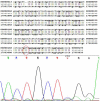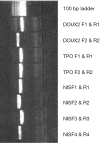Genomics and phenomics of Hashimoto's thyroiditis in children and adolescents: a prospective study from Southern India
- PMID: 26697440
- PMCID: PMC4671864
- DOI: 10.3978/j.issn.2305-5839.2015.10.46
Genomics and phenomics of Hashimoto's thyroiditis in children and adolescents: a prospective study from Southern India
Abstract
Background: Hashimoto's thyroiditis (HT) is the commonest cause of acquired hypothyroidism in children and adolescents in iodine non-endemic areas. The genetic analysis in HT shows two types of susceptibility genes-immune regulatory and thyroid specific genes. The exact genotype-phenotypic correlations and risk categorization of hypothyroid phenotypes resulting from these known mutations are largely speculative. The genetic studies in pediatric HT are very sparse from Indian sub-continent. In this context, we analysed the prevalence of TPO, NIS and DUOX2 gene mutations along with genotype-phenotype correlations in hypothyroid children with HT.
Methods: This is inter-disciplinary study conducted by collaboration between a tertiary care endocrinology hospital, biochemistry department of a teaching medical institute and genetics lab. In this prospective study, we employed 8 sets of primers and screened for 142 known single nucleotide polymorphisms in TPO, NIS, DUOX2 genes. The subjects were children and adolescents with hypothyroidism due to HT. Congenital hypothyroidism, iodine deficiency and dyshormonogenetic hypothyroidism cases were excluded.
Results: We detected 8 mutations in 7/20 (35%) children in the entire cohort (6 in NIS and 2 in TPO genes. No mutations were observed in DUOX2 gene. All our mutations were localized in introns and we found none in exons. Except for bi-allelic, synonymous polymorphism of TPO gene in child No. 18, all other mutations were heterozygous in nature. Genotype-phenotype correlations show that our mutations significantly expressed the presence of associated autoimmune manifestations and existence of family history. Clinical phenotypes of painful thyroiditis, severity of hypothyroidism and absence of goiter were statistically significant in the presence of these mutations. But, they could not reach significance on multivariate analysis.
Conclusions: NIS gene followed by TPO mutations appears to be most prevalent mutations in HT amongst South Indian children and these mutations significantly influenced phenotypic expressions such as severity of hypothyroidism, goiter, auto-immune manifestations and family history.
Keywords: DUOX gene; Hashimoto’s thyroiditis (HT); NIS gene; TPO gene; hypothyroidism.
Conflict of interest statement
Figures




Similar articles
-
Genotype-phenotype correlations of dyshormonogenetic goiter in children and adolescents from South India.Indian J Endocrinol Metab. 2016 Nov-Dec;20(6):816-824. doi: 10.4103/2230-8210.192923. Indian J Endocrinol Metab. 2016. PMID: 27867886 Free PMC article.
-
Antithyroid Peroxidase Antibodies in Multinodular Hashimoto's Thyroiditis Indicate a Variant Etiology.J Thyroid Res. 2019 Jul 21;2019:4892329. doi: 10.1155/2019/4892329. eCollection 2019. J Thyroid Res. 2019. PMID: 31428301 Free PMC article.
-
The association between thyroid volume, L-thyroxine therapy and hepatocyte growth factor levels among patients with euthyroid and hypothyroid goitrous and non-goitrous Hashimoto's thyroiditis versus healthy subjects.Endocr Res. 2016 May;41(2):110-5. doi: 10.3109/07435800.2015.1094084. Epub 2016 Jan 4. Endocr Res. 2016. PMID: 26726836
-
Hashimoto's Thyroiditis.Pediatr Endocrinol Rev. 2003 Dec;1 Suppl 2:205-11; discussion 211. Pediatr Endocrinol Rev. 2003. PMID: 16444160 Review.
-
Multiple Nutritional Factors and the Risk of Hashimoto's Thyroiditis.Thyroid. 2017 May;27(5):597-610. doi: 10.1089/thy.2016.0635. Epub 2017 Apr 6. Thyroid. 2017. PMID: 28290237 Review.
Cited by
-
Levothyroxine monotherapy versus levothyroxine and selenium combination therapy in chronic lymphocytic thyroiditis.J Endocrinol Invest. 2017 Nov;40(11):1243-1250. doi: 10.1007/s40618-017-0693-z. Epub 2017 May 22. J Endocrinol Invest. 2017. PMID: 28534148
-
25-OH Vitamin D blood serum linkage with VDR gene polymorphism (rs2228570) in thyroid pathology patients in the West-Ukrainian population.J Med Life. 2021 Jul-Aug;14(4):549-556. doi: 10.25122/jml-2021-0101. J Med Life. 2021. PMID: 34621381 Free PMC article.
-
Vitamin D receptor gene FokI but not TaqI, ApaI, BsmI polymorphism is associated with Hashimoto's thyroiditis: a meta-analysis.Sci Rep. 2017 Jan 30;7:41540. doi: 10.1038/srep41540. Sci Rep. 2017. PMID: 28134349 Free PMC article.
-
The C55A Single Nucleotide Polymorphism in CTLA-4 Gene, a New Possible Biomarker in Thyroid Autoimmune Pathology Such as Hashimoto's Thyroiditis.Diagnostics (Basel). 2023 Jul 28;13(15):2517. doi: 10.3390/diagnostics13152517. Diagnostics (Basel). 2023. PMID: 37568880 Free PMC article.
References
-
- Hashimoto H. Zur kenntniss der lymphomatosen veranderung der schilddruse (struma lymphomatosa). Arch Klin Chir 1912;97:219-48.
-
- Tunbridge WM, Evered DC, Hall R, et al. The spectrum of thyroid disease in a community: the Whickham survey. Clin Endocrinol (Oxf) 1977;7:481-93. - PubMed
-
- Sar E, Karaoglu A, Yeşilkaya E. Hashimoto’s Thyroiditis in Children and Adolescents. In: Huang FP, editors. Autoimmune Disorders - Current Concepts and Advances from Bedside to Mechanistic Insights. Rijeka: InTech, 2011.
-
- Kochupillai N. Clinical endocrinology in India. Current Science 2000;79:1061-7.
-
- Setian NS. Hypothyroidism in children: diagnosis and treatment. J Pediatr (Rio J) 2007;83:S209-16. - PubMed
LinkOut - more resources
Full Text Sources
Miscellaneous
